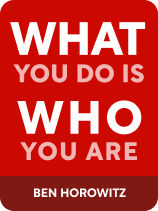

This article is an excerpt from the Shortform book guide to "What You Do Is Who You Are" by Ben Horowitz. Shortform has the world's best summaries and analyses of books you should be reading.
Like this article? Sign up for a free trial here .
What do successful cultures have in common? What should you make sure is built into your organization’s culture?
Businessman and author Ben Horowitz argues that you must cultivate two core elements of organizational culture if you want to succeed. All intentional cultures encompass the strengths of the leader and they undergird the organization’s strategy.
Read more to learn about these two elements.
Strength and Strategy
Horowitz emphasizes there is no perfect, one-size-fits-all culture because the behaviors and beliefs that work for one company may not work for another. However, he says there are two core elements of organizational culture that all intentional cultures share: They reflect the leader’s strengths, and they support the organization’s strategy.
(Shortform note: Silicon Valley culture, for all its innovation and value-creating power, is an example of a culture that doesn’t fit everywhere, even though many businesses and even countries have tried to emulate it. Some of the downsides of emulating Silicon Valley are the high percentage of failed ventures that are inevitable when favoring fast-paced innovation and the litany of scandals and unethical behavior that can result from its rule-book-ripping culture.)
Core Element #1: Successful Cultures Reflect Leaders’ Strengths …
First, Horowitz argues the culture you design should reflect who you are as a leader, your strengths, and beliefs, rather than emulate what other leaders do. If you start from your strengths, the culture you design will be sustainable because you’ll be implementing a style that comes naturally to you.
… But Avoid Leaders’ Weaknesses
The flip side is that your culture shouldn’t reflect your weaknesses, or characteristics that won’t serve the organization’s vision. Because your example as the leader sets the tone for the organization, your weaknesses can permeate the culture as employees emulate your behavior. To keep your weaknesses from infecting your culture, the author says you first need to become aware of them, then immunize your culture against them by establishing checks and balances. For example, if your weakness is conflict avoidance, hire assertive people, and set up policies that encourage dealing with conflict head-on.
| The Founder is 80% of the Culture Molly Graham, former head of Culture and Employment Branding at Facebook, has said that the founder is 80% of a company’s culture. The founder’s qualities and strengths become competitive advantages for the company, but only if the founder consciously builds them into the culture. She also says being aware of your weaknesses is essential, especially in those first rounds of hiring. She needs to hire people who can complement her weaknesses with the strengths that she’s lacking. To deepen their self-awareness, Graham recommends founders ask themselves these questions: What sets me apart from the people around me? How do I make my best decisions? What am I bad at? |
Core Element #2: Successful Cultures Support the Organization’s Strategy
The second core element of a successful culture is that it supports the organization’s strategy. Horowitz says your cultural features, such as policies, must encourage employees to act in ways that bring the company closer to its vision.
For example, flexibility and the opportunity to be creative are important features of Google’s culture. They support the company’s strategy of constant innovation and staying open to new lines of work by encouraging employees to explore new ideas, even if they’re outside of the scope of their current projects.
(Shortform note: If you’re looking to change your organization’s existing culture, making sure the new culture supports your strategy is key. Experts who studied the cultures of top-performing companies identified matching culture to strategy as the number one principle to follow.)

———End of Preview———
Like what you just read? Read the rest of the world's best book summary and analysis of Ben Horowitz's "What You Do Is Who You Are" at Shortform .
Here's what you'll find in our full What You Do Is Who You Are summary :
- The three reasons leaders should care about culture
- How a sense of purpose boosts employees' performance
- What the Samurai and Genghis Khan can teach you about leadership






